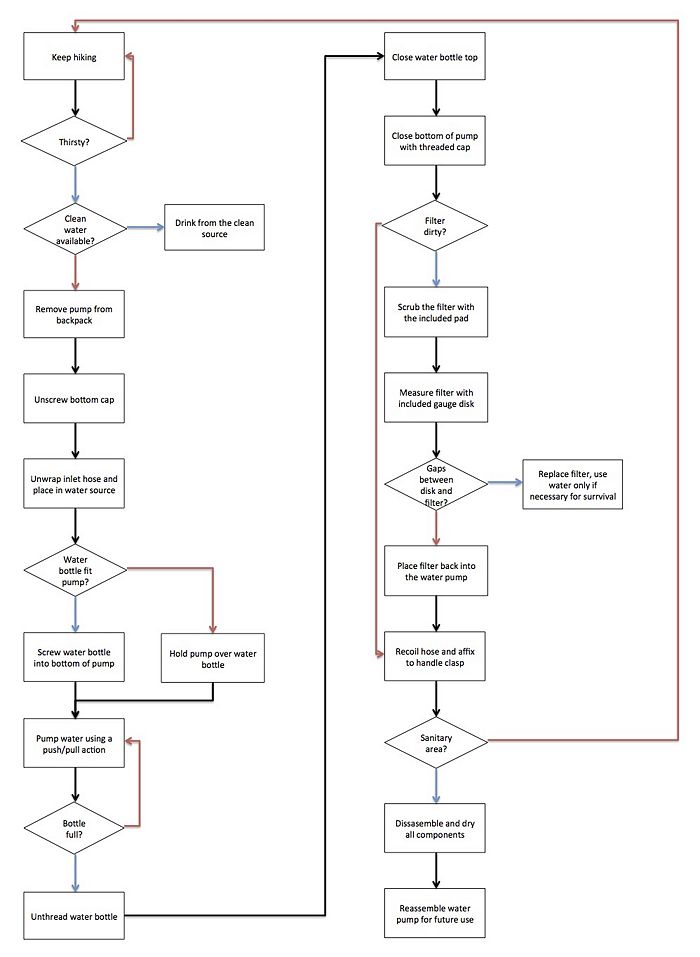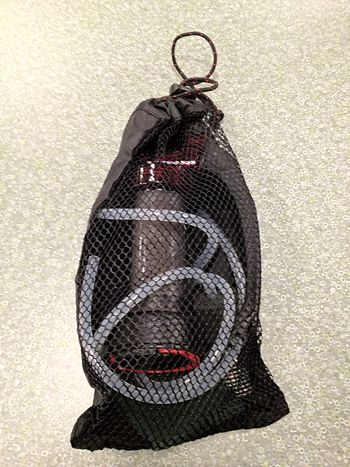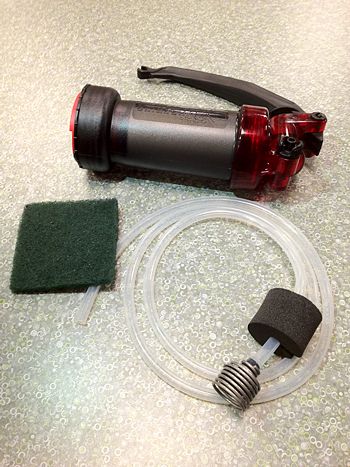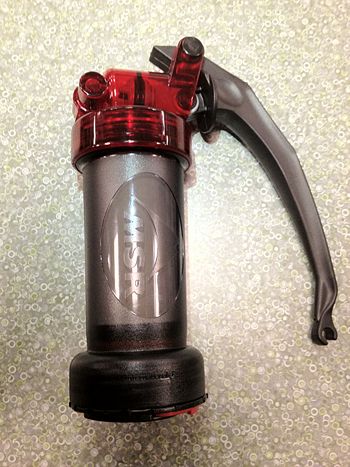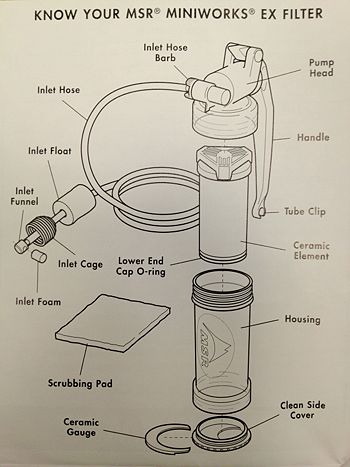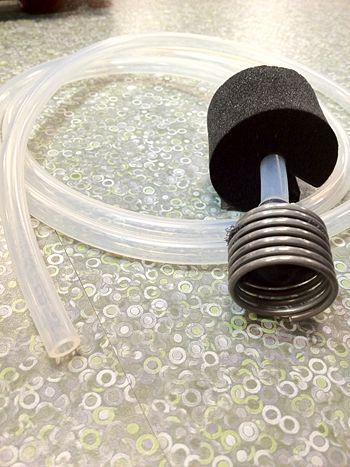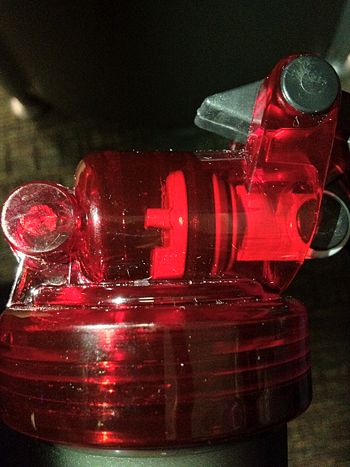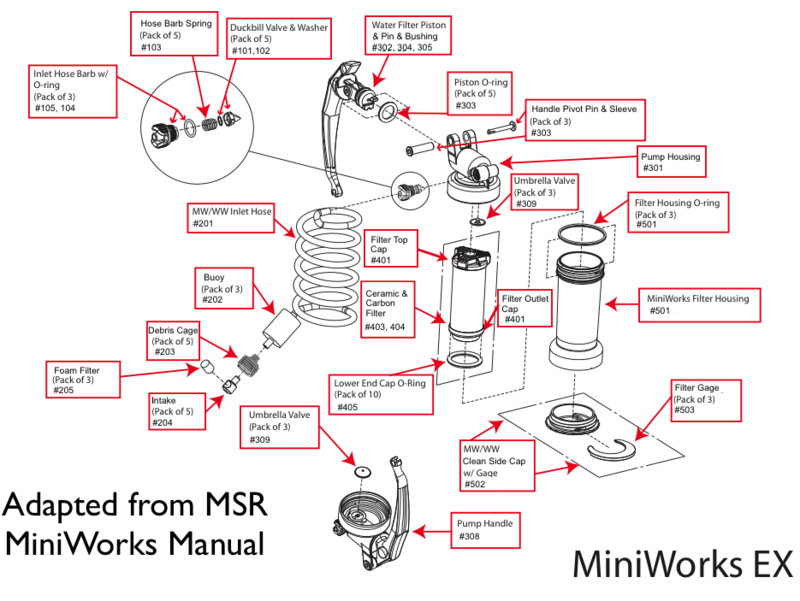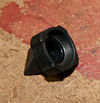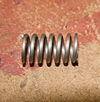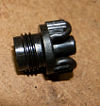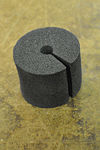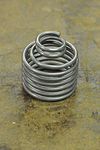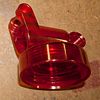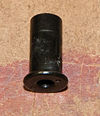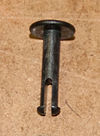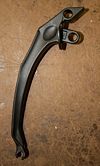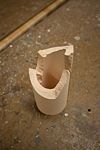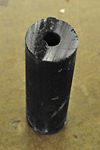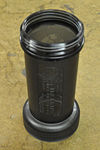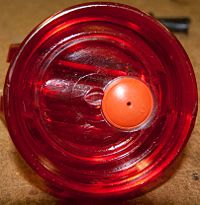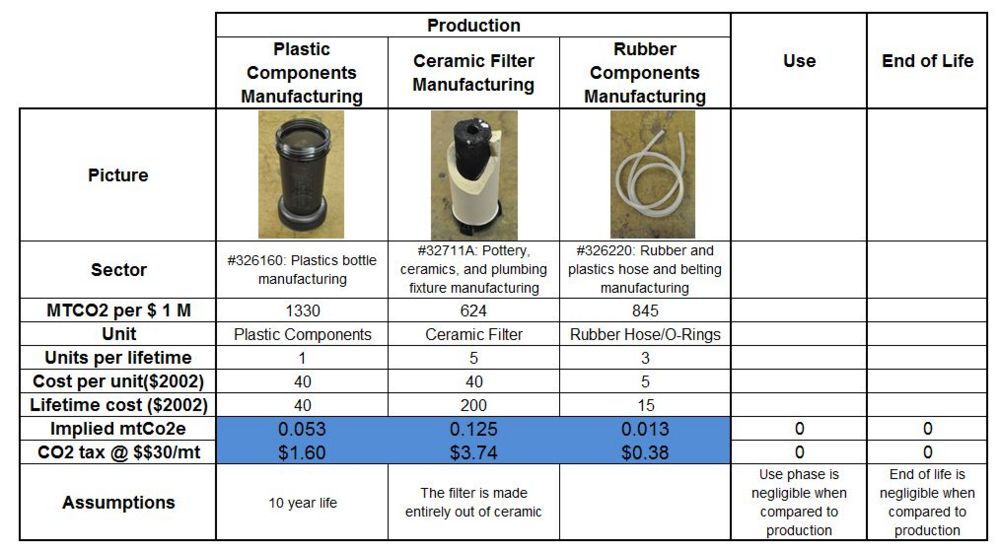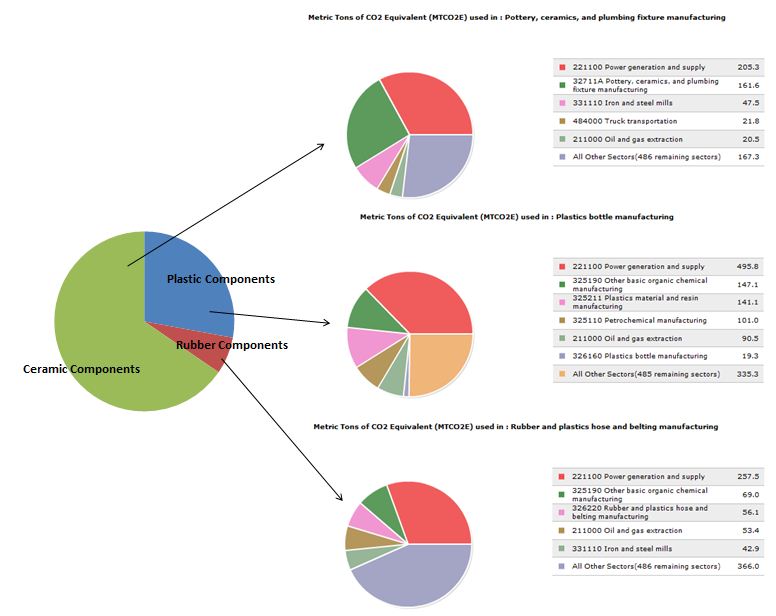Water filtration pump
From DDL Wiki
Contents |
Executive Summary
As a part of the design process for a portable water filter, a MSR MiniWorks EX Water Filter was purchased and analyzed. The pump was first dissassembled into individual components, and the team assessed possible areas for improvement in regards to DFM, FMEA, and DFE.
After conducting the DFMA analysis, the product was found to be highly optimized for large scale manufacturing, and used cheaper materials. It was also found that in order to facilitate user maintenance of the pump, the product was designed to be completely dissassembled by hand by the user. However, this results in difficulty of assembly during the manufacturing stage. A possible improvement on the design would be to simplify the design for assembly during manufacturing. The failure modes were analyzed by using risk priorities number (RPN) as a benchmark for determining the possible areas of improvement. The highest RPNs were found in failures associated with the filter and the filter O-ring. Design focus can be placed around these locations in order to effectively reduce the risks associated with the product. From the DFE analysis, the ceramic filter was found to have the highest costs, as well as the largest environmental impact. Improving the design of the ceramic filter, including the filter life, can most effectively reduce the costs to the consumer and environment. A possible solution is to include a prefilter, to minimize the particles that reach the main cartridge.
The analysis has identified points of interest where the design can be improved the most. Subsequent analysis will investigate these points further and determine possible design solutions.
Primary Stakeholders and Product Needs
The primary stakeholders and their needs for the product are listed below. The stakeholders are parties that have an vested interest in the product. Consumers, retailers, manufacturers, and shipping/transport were identified as the most important stakeholders in the product.
Consumers:
The consumers are the group of people that purchase and use the product, and therefore have a major interest in the product. As the product is a portable water filter, major target consumer groups are backpackers, and people without easy access to clean water.
- One of the most important functions of the water pump is that it pumps water. Without the ability to pump water, it can't push water through the filter, and thus can't filter water.
- Another important aspect is the drinkability of the water. The pump will need to eliminate dangerous pathogens and bacteria, or else the user of the product could get potentially life-threatening diseases. In addition, since the pump is meant to be used as a backpacking filter, medical first aid may not be readily available.
- The portability of the water pump is important as well, as it is meant to be a backpacking water pump. It needs to be carried, and so having a light product that can fit into a backpack is essential to the consumer.
- In order for the product to compete with similar products on the market, it must pump water quickly and efficiently. The pump can't be too hard to operate.
- The pump must also be cheap in order to be competitive with similar products.
- As the pump is meant to be taken backpacking, the pump must be durable. It should be able to sustain loads that could result from being thrown into a backpack. As having a source of water is vital, the pump breaking in the middle of a backpacking trip could not only be inconvenient but dangerous to the consumer.
- Product lifetime and filter lifetime are both important factors in a consumers decision as well. The longer lasting the product and the filter, the less hassle and cost it is for the consumer.
- Using sustainable materials for the water filter is important as well. The target consumers generally spend a lot of time in nature and appreciate the importance of using sustainable materials and processes in creating the product
- Since the water filter could be contaminated and needs to be cleaned regularly, the ease of cleaning and sterilization of the water pump is very important.
- The product must also be safe, as there are moving parts, and could be a potential cause of injury.
- Finally, the product should work with existing products such as Nalgene and CamelBaks, as many backpackers already have these products, and would prefer to choose a product that works with equipment that they already own.
Retailers:
The retailers are another group that has a major interest in the product. The retailers sell the product to the customer, in exchange for profit. The target retailers include outdoor equipment and sports stores such as REI and Dicks, as well as internet vendors such as Amazon.
- The price of the product is very important to retailers, as it affects their profit margin, and the quantity of product they can sell.
- The sustainability is important to many retailers, especially for retailers that have sustainability as part of their brand image.
- An attractive product will stand out to consumers more, and will contribute to sales. This is important especially in comparison to similar products.
- As the bottom line of the retailer is profit, the profitability of the product is very important to the retailer. Even if a product sells well, if the profitability is low, the retailer will not see a lot of profit, and will not want to carry the product.
- Safety is an important factor to the retailer, as the retailer will be partly responsible for any injuries from products it carries.
Manufacturers:
Manufacturing is an important stakeholder, as it is responsible for the creation of the product. The effects of manufacturing can be felt downstream by the retailers and consumers as well.
- The manufacturing of a product represents the majority of the cost of the product. Therefore, keeping manufacturing costs low will in turn have a big effect on the final retail price and profitability as well.
- Having a simple design with few parts will help decrease the assembly complexity and the number of necessary processes, thereby keeping the cost low.
- The design must also be compatible with large scale manufacturing processes such as injection molding. By doing so, the cost for creating a large quantity of the product will go down.
- The ease of assembly of the product will help keep assembly costs low, and also make the product easily maintainable by the consumer as well.
- Using standardized, interchangeable parts will eliminate the need of custom parts, and simplify the manufacturing process as well as lower cost.
- All processes and parts must be safe for the worker to handle, and be in accordance to any government regulations such as OSHA.
Shipping/Transport:
As shipping and transport can constitute a significant cost, it is necessary to be cognizant of shipping and transport needs.
- The product needs to be sturdy, so it won't be easily damaged during shipping. A fragile product needs extra packaging and handling care, which will be an additional cost to the company.
- As the weight of a product has a significant effect on the gas mileage of vehicles, the weight of the product is an important factor.
- A compact product will allow more of the product to be shipped together, thereby lowering the cost of shipping.
Product Function and Evaluation
The MSR MiniWorks Pump operates via an oscillating piston with two one-way valves. A duck valve is inline with the pump head and housing to prevent excessive pressure buildup in the housing. The entire product can be completely dismantled in-field, and can be maintained with little prior knowledge. The design seems very simple yet efficient in its purpose.
Usage
Find the cleanest possible source of water. The intake hose is unwound, and then the intake hose is inserted into the water source. Attach the pump to the water container. Pump water at a steady rate, until container is full. Pull the intake hose out of the water, and pump to clear pump of any additional water.
Mechanical Function
The product contains a lever that is attached to an oscillating piston with two check valves. On the intake stroke, the intake check valve allows water to travel through the water source into the piston. On the compression stroke, the intake check valve is closed and the bottom check valve allows water to be forced through the filter chamber. The filtered water is then sent out of the pump. A duck valve lies between the pump head and housing to prevent a buildup of pressure. If the input flow is greater than the outlet flow, then the spring on the duck valve will compress and pressure will be released.
Preliminary User Study
Our group conducted a preliminary user study and determined that the product was self explanatory for either experienced hikers or anyone with moderate technical know-how (i.e. CMU engineering majors). Our group was able to completely dismantle the product without the use of any tools and easily discern the purpose of each part. This product would only need to be purchased by someone with a lot of experience in hiking and the outdoors, as someone without this experience should not be taking trips during which they won't have access to drinkable water. Therefore, nobody should be using it without any prior knowledge.
There are many well-thought-out features which exhibit themselves through simple use. First off, the outlet of the pump is threaded the same size as a Nalgene bottle, so that the pump can sit directly on the bottle and there is no risk of contamination. The included cap for the outlet of the pump also serves to reduce contamination when not in use. The rubber hosing wraps around the pump housing and is secured by a small c clamp in the handle. This serves to not only hold the handle down when when not in use (and prevent incidental breaking), but the c-clamp is properly sized so that it squeezes the hosing closed to prevent excess contamination. Finally the handle is contoured to fit well with the averaged sized in a comfortable pumping position.
Not many issues arise when using the MSR water pump. The most notable problem lies in the fact that the pumping action is cramped and requires several minutes to fill a hiking-sized water bottle. If there were a way to reduce the pumping effort required while keeping the small footprint of the product, it would probably be very beneficial. The only other foreseeable issues are broken parts or a clogged filter, which we didn't encounter and couldn't simulate during this study.
List of Parts
The following details the list of parts of a MSR MiniWorks EX Microfilter.
| Part Number | Name | Quantity | Mass (g) | Subassembly | Function | Material | Manufacturing Process/ Purchased Component | Image |
|---|---|---|---|---|---|---|---|---|
| 101 | Duckbill Valve | 1 | 0.5 | Hose Barb | Acts as a check valve, so that water can be pumped in through the hose, but not out | Plastic | Injection Molding | |
| 102 | Hose Barb Washer | 1 | <1 | Hose Barb | Sits between the duckbill valve and the spring | Steel | Purchased | |
| 103 | Hose Barb Spring | 1 | 2 | Hose Barb | Acts as the pressure relief in the check valve | Steel | Purchased | |
| 104 | Hose Barb O-Ring | 1 | 0.5 | Hose Barb | Prevents water leaking from the hose barb | Rubber | Purchased | |
| 105 | Hose Barb | 1 | 3 | Hose Barb | Connects to the hose | Plastic | Injection Molding | |
| 201 | Hose | 1 | 44 | Inlet Hose | Serves as the inlet hose of the contaminated water | Rubber | Purchased | |
| 202 | Buoy | 1 | <1 | Inlet Hose | Prevents the hose from sinking to the bottom of the water source | Foam | Foam Molding | |
| 203 | Debris Cage | 1 | 11 | Inlet Hose | Acts as a pre-filter and as a weight so that the hose stays below water | Steel | Purchased | |
| 204 | Intake | 1 | 1 | Inlet Hose | Water inlet, and also holds the foam filter | Plastic | Injection Molding | |
| 205 | Foam Filter | 1 | <1 | Inlet Hose | Acts as a pre-filter for large particles | Foam | Foam Molding | |
| 301 | Pump Housing | 1 | 56 | Piston | Contains piston and hose barb assemblies, and connects to filter | Plastic | Injection Molding | |
| 302 | Piston | 1 | 9 | Piston | Acts as the pump by drawing in and pushing out water | Plastic | Injection Molding | |
| 303 | Piston O-Ring | 1 | 2 | Piston | Prevents water from getting past the piston | Rubber | Purhcased | |
| 304 | Piston Pivot Sleeve | 1 | 1 | Piston | Connects piston to the handle | Plastic | Injection Molding | |
| 305 | Piston Pivot Pin | 1 | <1 | Piston | Connects piston to the handle | Plastic | Injection Molding | |
| 306 | Handle Pivot Sleeve | 1 | 2 | Piston | Connects handle to the pump housing | Plastic | Injection Molding | |
| 307 | Handle Pivot Pin | 1 | 1 | Piston | Connects handle to the pump housing | Plastic | Injection Molding | |
| 308 | Handle | 1 | 49 | Piston | Lever arm for the piston | Plastic | Injection Molding | |
| 309 | Piston Umbrella Valve | 1 | <1 | Piston | Allows water to be pumped through the filter, but no back flow of air | Rubber | Injection Molding | |
| 401 | Top Cap | 1 | 18 | Filter | Holds filter together | Plastic | Injection Molding | |
| 402 | Outlet Cap | 1 | 10 | Filter | Holds filter together, and works as water outlet | Plastic | Injection Molding | |
| 403 | Ceramic Filter | 1 | 42 | Filter | Filters contaminated water | Ceramic | Ceramic pouring and baking | |
| 404 | Carbon Filter | 1 | 34 | Filter | Filters remaining contamination from water | Carbon | Compression Molding | |
| 405 | Filter O-Ring | 1 | 4 | Filter | Prevents contaminated water from flowing past filter | Rubber | Purchased | |
| 501 | Filter Body | 1 | 97 | Body | Holds filter | Plastic | Injection Molding | |
| 502 | Clean Cap | 1 | 18 | Body | Prevent contamination of water outlet | Plastic | Injection Molding | |
| 503 | Filter Gauge | 1 | 5 | Body | Measure filter to determine when to replace | Plastic | Injection Molding |
Design For Manufacturing and Assembly
DFM
Dissection of the MSR Miniworks water filter shows clear attention to ease of manufacture and assembly by its designers. The majority of the product’s structure is made of relatively thick walled injection molded plastic components. The pump handle, piston, pump head, filter housing and clean side cover among many other pieces are injection molded before assembly. These parts are cheap and easy to manufacture but in the case of the Miniworks, may require very complex and expensive injection molding tooling. Some examples of complex molding on the Miniworks are the pump head and filter housing, which both require unscrewing devices or finishing operations to create internal threads, and the inlet hose barb which most likely requires a side action. Despite their complexity, these tools and processes are clearly well optimized and avoid unnecessary finishing operations (visible on the inner surface of the pump head) while creating very attractive components.
Overall, the material choice and construction clearly have manufacturability in mind. There are only 3 metal parts in the entire assembly (the inlet cage, relief valve spring and duckbill washer). All other parts aside from the ceramic and carbon filter elements are plastic, rubber or foam and extremely easy to produce on a large scale or purchase from another manufacturer in the case of O-rings and washers.
DFM Summary
- The Miniworks is designed with large volume production in mind.
- MSR has employed complex and expensive molding techniques in order to lower the overall part count and complexity of the device.
- MSR has gone to great lengths to optimize their injection molding design and efficiency, resulting in little waste in the manufacturing stage.
- The Miniworks is constructed mainly of cheap materials that are friendly to large volume production techniques.
DFA
Dissecting the Miniworks showed that its designers prioritized ease of assembly and disassembly by the user over assembly on the manufacturing line. A moderately experienced user is able to completely disassemble or reassemble the entire filter from individual components in a matter of minutes while causing minimal additional wear on its components. Since the components are designed for hand assembly, it is possible that more complicated assembly processes such as robotic arms or human labor are necessary or cost effective for final assembly in the factory. An example of this phenomenon is present in pump head pin and piston pin. These fasteners (the only two present in the product) may be more difficult for a machine to align and insert on an assembly line than cheaper, less durable snap-together components, and are consciously designed in such a manner to facilitate human assembly and longevity. These pins in the pump head and piston pivot are also most likely more expensive to produce than snap-together joints. MSR made this sacrifice in order to allow the Miniworks to be be disassembled and reassembled multiple times without its components degrading. This decision was most likely advantageous since this assembly and disassembly is part of the product's normal use. The designers of the Miniworks also prioritized ease of assembly over component simplicity, especially in the case of their injection molded components.
The designers of the Miniworks clearly believed that trading component simplicity for assembly simplicity would offset the additional initial tooling and process costs by increasing sales due to the filter’s ease of maintenance.
DFA Summary
- The designers of the Miniworks prioritized ease of user assembly and disassembly over assembly on the manufacturing line.
- User assembly and disassembly is part of the product's normal use and was wisely not ignored by MSR.
- This design decision may have slightly increased the assembly and part costs associated with manufacturing the product.
Failure Mode and Effect Analysis
Failure mode and effect analysis, or FMEA, is a guideline in evaluating potential problems existing in products. FMEA identifies the failure modes of the product by investigating the cause, the effects, and the detections of each failure. These categories can be used to quantify the severity (S), occurrence (O), and detection (D) of the failure, which can be multiplied to determine the failure's risk priority number (RPN). By separating and analyzing the different components of the water filtration pump, several failure modes were found as shown in the following table.
| Failure Modes and Effects Analysis - Water Filtration Pump | |||||||||
|---|---|---|---|---|---|---|---|---|---|
| Item & Function | Failure Mode | Effects of Failure | S | Causes of Failure | O | Design Controls | D | RPN | Recommended Actions |
| Pin | Shearing | Unable to move the piston to pump water | 7 | Use of handle with excess force | 3 | Load testing on pin | 1 | 21 | Stronger material to prevent shearing |
| Duck-Valve Spring | Fatigue/Weaken | Inefficient pumping of water in which some water may escape/leak when pump compresses | 5 | Overuse/Small particles rubbing against | 1 | Fatigue/Cyclic testing | 4 | 20 | None |
| Piston O-ring | Fatigue/Damaged | Leaking down the back of piston/Inefficient pumping of water | 4 | Overuse/Small particles rubbing against | 4 | Tolerance testing on O-rings | 3 | 48 | Tighter tolerances |
| Clean Cap | Contamination | Contamination of clean water source | 10 | Dropping bottom cap into dirty source | 5 | Information not available | 1 | 50 | Redesign - Attach a harness to catch it from falling too far |
| Piston Umbrella Valve | Fatigue/Damaged | Inefficient pumping of water in which water might be drawn out during the expansion of the piston | 7 | Overuse/Small particles rubbing against | 1 | Tolerance testing on O-rings | 5 | 35 | Tighter tolerances |
| Filter O-ring | Fatigue/Damaged | Contamination of clean water source as dirty water leak into clean water exit | 10 | Overuse/Small particles rubbing against | 3 | Tolerance testing on O-rings | 8 | 240 | Tighter tolerances |
| Filter | Clogging | Difficulty in pumping the water through the filter | 4 | Overuse/Small particles remaining after filtering | 7 | Cyclic testing | 2 | 56 | Pre-filter to prevent clogging |
| Cracking of ceramic part of filter | Ineffective filter to cleanse water to drinkable water | 9 | Dropping the water filter | 6 | Impact testing on filter | 8 | 432 | Cushion the filter so that it reduce chance of cracking | |
| Filter Body | Cracking in the main body around the filter | Leaking of water (does not contaminate clean water) | 6 | Dropping the water filter | 3 | Impact testing on case | 1 | 18 | Stronger material to reduce chance of cracking |
| Cracking through the filter part to the bottom cap | Leaking of water (does contaminate water) | 10 | Dropping the water filter | 3 | Impact testing on case | 1 | 30 | Stronger material to reduce chance of cracking | |
| Handle | Shearing/Breaking | Unable to move the piston to pump water | 7 | Dropping the water filter/Pulling with excess force | 4 | Test handle strength | 1 | 28 | Stronger material to prevent shearing/Control failure so that something else fails before handle |
As seen in the table, the parts with the highest risk priority numbers are the filter and the filter O-ring. The effects of the failures are similar in which when those parts fail, they would make the filter ineffective such that it does not provide clean drinkable water. Recommended actions for improving the filter would be to redesign a pre-filter to extend the life of the filter and to prevent it from clogging or redesign the filter such that would be protected from cracking and damages. Recommended action for improving the filter O-ring would be to increase the tolerance of the O-ring.
Design for Environment
Design for Environment, or DFE, can give important insight on what areas to focus while improving a design. By analyzing the entire life cycle, the areas of the largest impact can be determined. Focusing on these can most effectively reduce the costs that are associated with the product. To do this, a full life-cycle analysis was conducted on the water filtration pump. It was determined that no greenhouse gasses were produced during the use stage of the pump and that the impact associated with the end of life is negligible compared to the resources consumed during production. In order to get a better insight, the production of the water pump was split into plastic components, the ceramic components, and the rubber components.
After conducting the analysis, it is evident that the ceramic filter has the largest carbon footprint. The reason for this, is that the filter has to be changed often throughout the entire life of the product. A clear way that impact and cost can be lessened, is to improve the design of the filter such as increasing its life. The second largest impact in the life cycle of the product is plastic manufacturing. Improvements can be made in this area by making smaller and lighter plastic parts. Some greenhouse gas emissions are inadequately represented by the model of plastic bottle manufacturing. These come from transporting the products to peoples homes and to outdoor retailers in small quantities. Because the filters often get sold one by one, truck transportation would be a large addition to the carbon footprint of the product. The design of the product can be improved in this area by reducing the packaging size and weight, and by using the packaging as the shipping box of the product. The environmental impact of the water filter can be lowered by reducing the amount of material used.
Team Members
Ibuki Kamei - Team Leader
Paul Kimball - Product Usage Study
Fedya Kleshchev - DFE
Hugh Ross - DFMA
Frank Wu - FMEA
Since the team had 5 members and the project had 5 positions, we delegated each position to a member was interested in it. We have weekly meetings in which we assigned discussed tasks that needs to be completed and received feedbacks on our positions and work that was due each week.
References
Cascade Designs, Inc. MSR MiniWorks EX Water Filter. 24 Jan. 2012. Instruction Manual. Seattle, WA.
Carnegie Mellon University Green Design Institute. (2008) Economic Input-Output Life Cycle Assessment (EIO-LCA), US 1997 Industry Benchmark model [Internet], Available from:<http://www.eiolca.net> Accessed 1 February, 2012.
Dieter, George E., and Linda C. Schmidt. Engineering Design. 4th Edition. New York, NY: McGraw-Hill, 2009. 707-715. Print.
"MSR® MiniWorks™ EX Microfilter Schematic." MSR. Cascade Designs, Inc. Web. 12 Feb. 2012. <http://cascadedesigns.com/msr/water-treatment-and-hydration/expedition-water-treatment-and-hydration/miniworks-ex-microfilter/product>.
